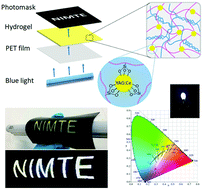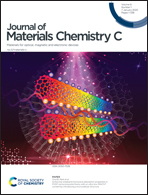White-light-emitting flexible display devices based on double network hydrogels crosslinked by YAG:Ce phosphors†
Abstract
White-light-emitting materials have attracted great research interest for applications in lighting, flexible display devices and biosensors. Traditional inorganic white-light-emitting materials are hard and brittle, making them difficult to apply in the field of flexible display devices. In this study, flexible and stretchable white-light-emitting double network composite hydrogels were prepared using vinyl-modified Ce-doped yttrium aluminum garnet phosphors (YAG:Ce–VTES) as crosslinkers and photoluminescent centers. The hydrogel is composed of an interpenetrating polyacrylamide (PAAm) network crosslinked by YAG:Ce–VTES and an ion-crosslinked calcium alginate network. The alginate/PAAm double network hydrogels show good stretchability and toughness, with a fracture elongation up to 600% and a compression strength up to 3.6 MPa. Moreover, white-light-emitting flexible display devices have been illuminated using a blue backlight with high luminous efficiency, optical stability and low cost. This strategy provides white-light-emitting hydrogels with good mechanical properties and lays a foundation for applications of flexible lighting and display devices.



 Please wait while we load your content...
Please wait while we load your content...